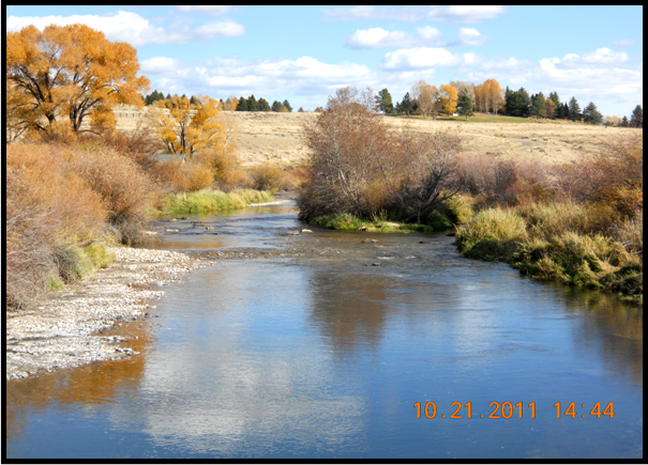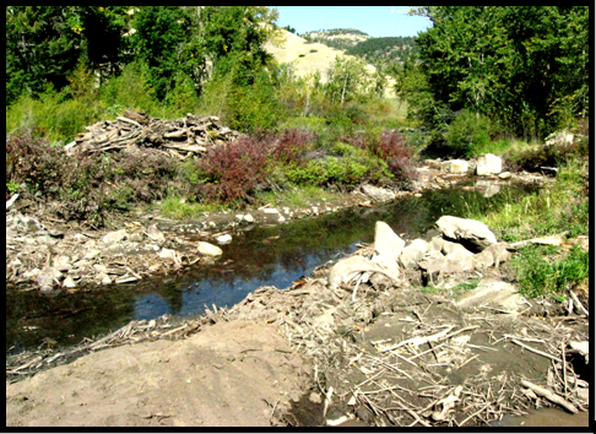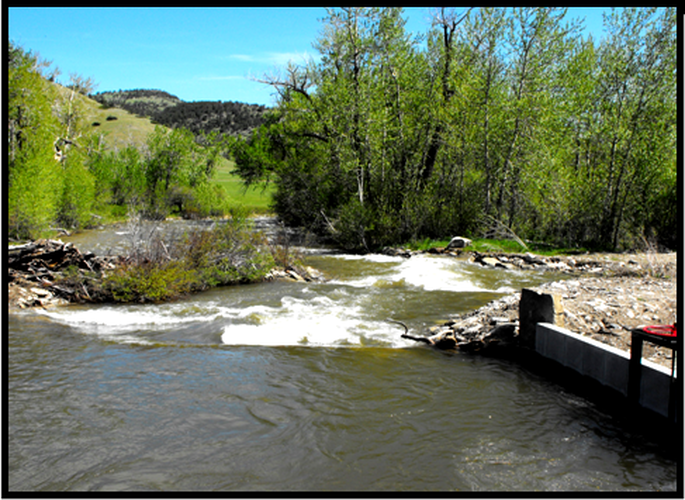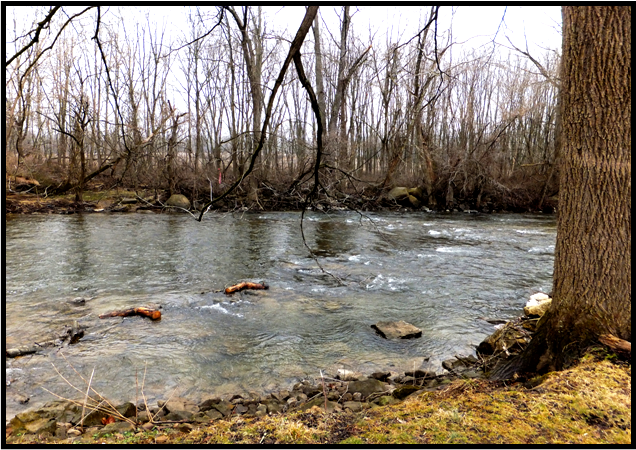Trout Run, Wyoming River Restoration Project to Improve Fisheries for Private Fishing Club1/24/2020 Aquatic Wetland Restoration The countryside of Wyoming represents an important part of the United States' geological history. During a large geological event millions of years ago, the shifts of the area in what is today known as the midwest gave way to a transitional landscape. Parts of the flat land dropped, like in the North Platte River Basin of Wyoming, ( https://www.wyohistory.org/encyclopedia/north-platte-river-basin) and the other westward half rose upward, in what became the beginning of the Rocky Mountains. The transition is still in place today and created a unique transition into the habitat of the wild west. The river basin now provides for essential wildlife habitat as the watershed provides a large number of freshwater springs in the open country. Besides being an important geological junction with a large number of archaeological sites, the countryside also happens to provide for great fly fishing habitat. For those avid fishermen, unfortunately, most of the land is privately owned. There do happen to be several private fishing clubs though where those looking for ideal fisheries and secluded streams can toss in, like the one we worked with along the banks of Trout Run. Fisheries Restoration and Population Enhancement of the Privately Owned Trout Run Trout Run is a side channel of the North Platte River that runs through a private fishing club near Saratoga, WY. Beginning in August 2011 Urbani Fisheries, in conjunction with the areas private fishing club, the Local Conservation District, and the Wyoming Natural Resource Foundation, began restoration work on 2 miles of river. The goal of this project was to improve the trout and wildlife habitat and increase wild trout fishing opportunities along this stretch of waterway. How Urbani Fisheries Specializes in Wetland Restoration to Revamp a Dwindling Fish Population Urbani Fisheries works in-step with their clients to achieve their goals using a specialized holistic approach. When beginning a project, fisheries areas are first assessed to determine how best to proceed with the wetland restoration project. Surveys are taken and specifics, such as the best types of fish populations to add and recuperate, are then discussed and planned out. Once a project has been assessed and redesigned, the construction begins. Further instruction on what to expect post-restoration is always given, but the goal of each project is to aim for little to no continued maintenance.
When working in both private and public fisheries, the goal is to create a sustainable habitat. As fly fishers ourselves, we take pride in revamping a beautiful fishing spot and bringing back a thriving native fish population. Feel free to get in touch to discuss possible issues if you are noticing a dwindling population in your past favorite fishing areas. It may be as simple as a few tweaks to your private waterways!
3 Comments
River Diversion Rehabilitation Project A waterway can be tricky. The ebb and flow depends on the time of year and creates its own unique habitats throughout the process. Mapping and understanding the formation of a waterway is even more difficult. From the plants growing there to natural obstructions and fish spawning habitats, multiple factors come into play and determine whether a wetland is prime fisheries habitat or a small trickling stream. We use our experience and specialized design skills to determine how best to convert a waterway into a prime aquatic habitat. We take into account all biological stages and use environmental engineering to keep our fisheries on the thriving side. To counteract natural ebbs and flows, certain techniques are used, such as diversion, to naturally recreate a steadily flowing stream. Our project on the West Boulder River had already been diverted, but incorrectly. The process of diversion for whatever reason may seem simplistic, however, the expected outcome may differ due to multiple factors that were previously not an issue. Too much flow in one direction may cause an embankment to erode, or a lack of depth may cause the fish population to drastically decline. Such is partially the case of our West Boulder River restoration project. Environmental Engineering to Recreate and Restore Natural Aquatic Habitats As can be seen in the photo, the previous point of diversion consisted of a headgate that was located on a side channel of the West Boulder River. The side channel received consistent flow from the main thread, however, it was perched above the main channel such that its flow was commonly too shallow to satisfy diversion requirements at the headgate. The shallow water created the ideal space for blockages to become trapped and accumulate. During spring runoff, the side channel was chronically prone to sediment and woody debris accumulation, promoted by the current headgate/weir configuration. The accumulated deposits required extensive annual maintenance. To deepen flows at the headgate, a rock weir was installed below the headgate structure. The proposed project was designed to maintain necessary water surface elevation that also ensured water delivery to the irrigation ditch. Construction of a stable weir structure was intended to facilitate conveyance of both debris and sediment past the structure, and the relocation of the headgate to the channel margin was designed to remove backwatering that promoted woody debris accumulation.
From the post-construction picture, you can see the headgate was realigned so that it did not impede natural flow paths along the bank. Urbani Fisheries completed this project in 2009 with their work emphasizing
Aquatic Habitat & River Restoration ProjectThe Musconetcong River is located in northwestern New Jersey and is a major tributary of the larger Delaware River, making it an important part of the river's watershed. The entire river runs through rural, mountainous terrain of approximately 45 miles. Urbani Fisheries worked in conjunction with multiple agencies to enhance the fish habitat in two separate areas. Although the river restoration did not take long, the permitting process was extensive. Working with Trout Unlimited to Restore Approximately Half a Mile of Decimated RiverOne section of the waterway that was scheduled for river construction flows through two private properties. After entering into an agreement with NRCS and Trout Unlimited, Urbani Fisheries worked with the two organizations for three years through the permitting process to eventually begin the restoration work on February 21st. The scope of work included restoration and habitat enhancement for adult and juvenile trout on 2,500 linear feet of the river. Work included surveying, river and habitat assessment, design, agency site reviews, reorganization of existing structures. Pools and riffles were created along with point bars. Riverbanks were stabilized by thalweg re-direction and boulder cluster placement. The entire project was completed on February 28th, 2012. Heritage Conservancy at Work on a Mission to Preserve National Heritage Area The other section of the river that Urbani Fisheries was involved in reconstructing was an area of the property preserved by the Heritage Conservancy. Heritage Conservancy is an NGO based out of Pennsylvania with the mission to preserve and protect national heritage. They work throughout the region to restore open land, wildlife habitat, farmland, and watershed areas. Urbani Fisheries, in conjunction with the Heritage Conservancy and Trout Unlimited, worked again for three years through the permitting process to eventually begin the river restoration work on February 18th. The scope of work included the river restoration and habitat enhancement for adult and juvenile trout on 1,200 linear feet of the river. Work was similar in both sections and included surveying, assessments, custom designs and agency site reviews that were all meant to enhance spawning habit and increase the fish population. By the reorganization of existing structures and constructing pools, riffles, and point bars the riverbank was able to be stabilized again by thalweg re-direction and boulder cluster placement. This section was completed on February 20th. Utilizing Existing Habitat to Redesign the Fish Habitat in River Restoration Projects Urbani Fisheries uses their experience to create wetland habitats with a holistic approach that focuses on sustaining fisheries habitat. By first assessing the area and thoroughly planning an approach, we create river restoration projects that last past the construction and require little to no maintenance. The specialized engineering accounts for the need for prime fish living and breeding spaces, and by rearranging specific areas and acknowledging the natural flow of the river, we are able to
Every project requires its own custom assessment and design. Many construction companies simply work with the land to create an area that is suitable to the owner's requirements in terms of shape and size. We work with the project managers to ensure we are meeting their goals and also assessing the natural ecosystems to not only create a project that is appealing to the eye, but naturally functional and sustainable long term. Contact us for questions about our restoration process or if you have questions concerning your sections of streams and rivers. From local Montana fishermen and biologists who love to fly fish, we know it isn’t just a matter of where to find the fish, but how to get them there.
|
Categories
All
Archives |












 RSS Feed
RSS Feed